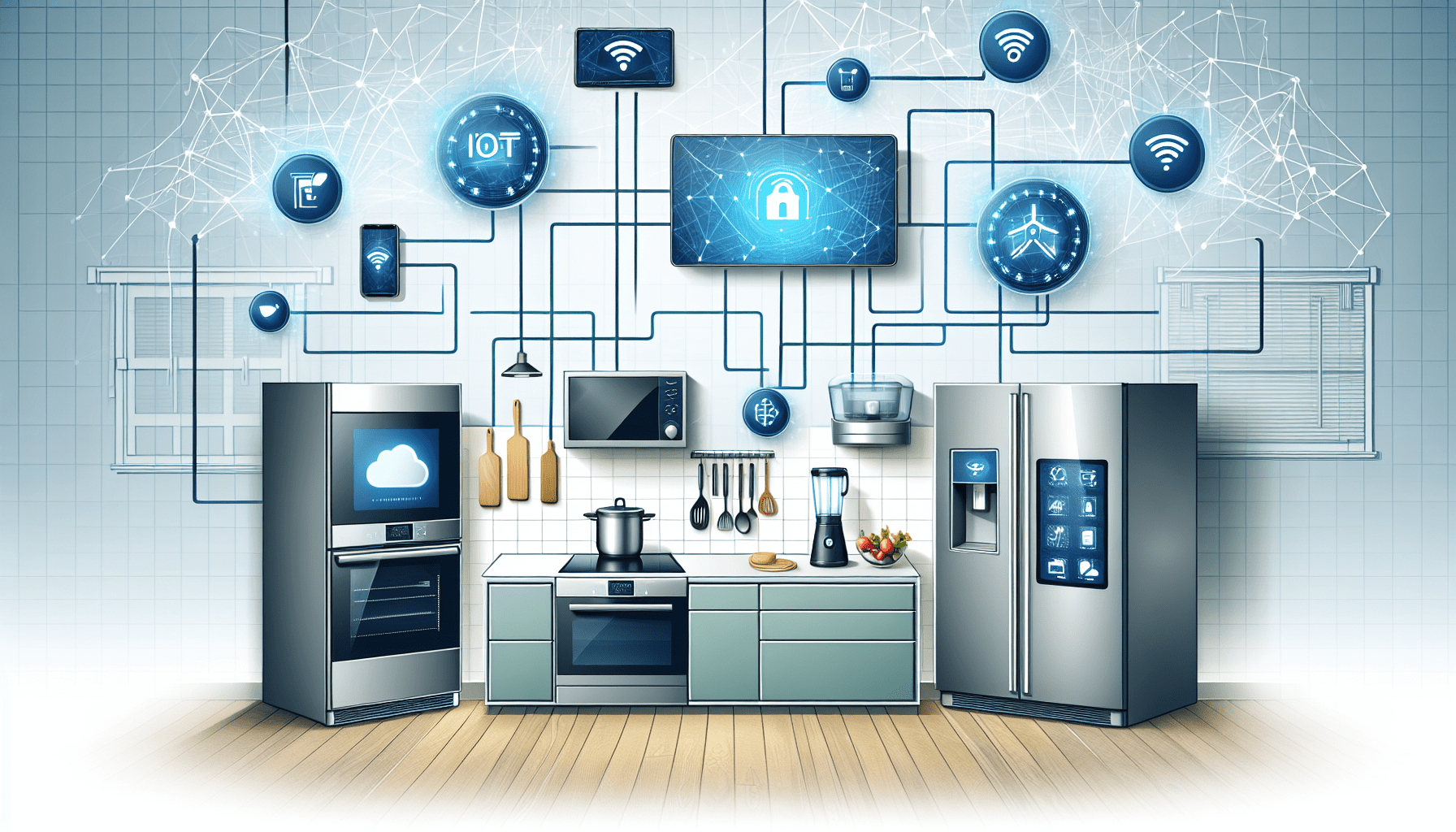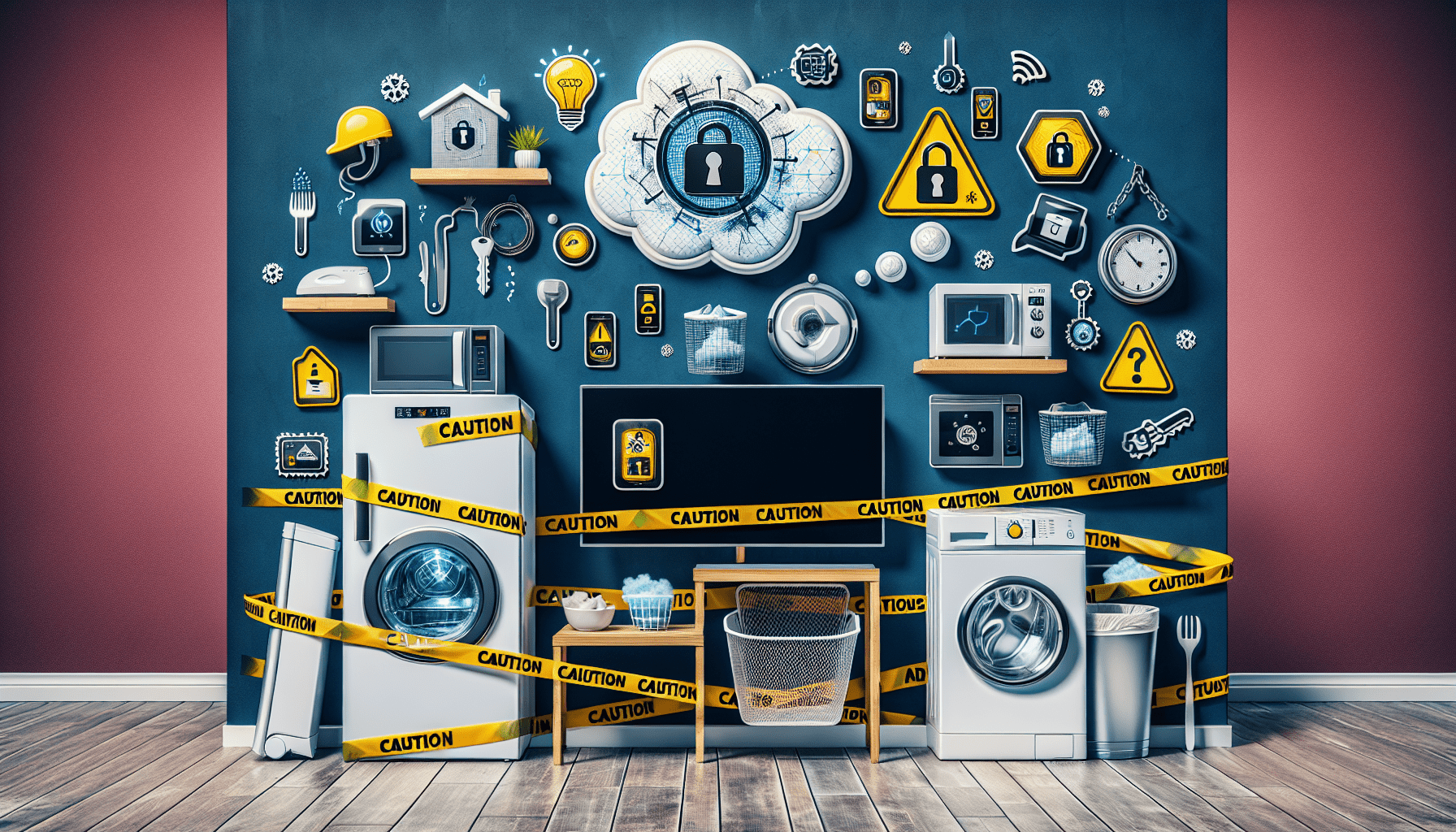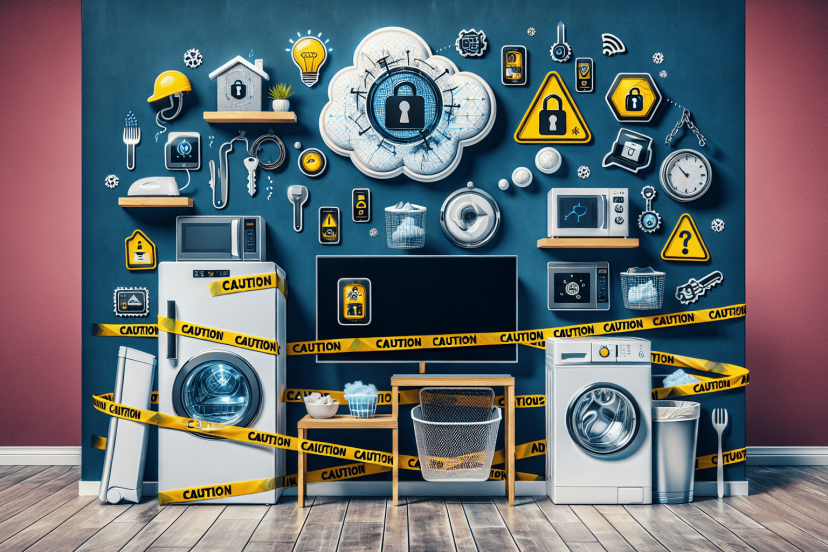What Are The Disadvantages Of Smart Appliances?
Smart appliances may seem like the ultimate solution to make our lives easier and more convenient, but have you ever wondered about their drawbacks? As technology advances and more and more households embrace these intelligent devices, it becomes crucial to examine the potential downsides. From higher costs to privacy concerns, this article will explore the less glamorous side of smart appliances and shed light on the possible disadvantages you might encounter. So, before you hop on the smart appliance bandwagon, let’s take a closer look at what you need to consider.

Increased Cost
Higher initial purchase cost
Smart appliances often come with a higher price tag compared to their traditional counterparts. While the initial investment may seem hefty, it is important to consider the additional features and technology embedded in these devices that contribute to the increased cost. However, it is also worth noting that with advancements in technology, the prices of smart appliances have been gradually decreasing, making them more accessible to a wider range of consumers.
Potential for additional costs
Apart from the higher initial purchase cost, smart appliances can also lead to potential additional costs. For instance, some smart appliances require subscription fees for accessing certain features or services. These recurring expenses can add up over time and have an impact on your overall expenditure. It is crucial to consider these additional costs and evaluate whether the added convenience and functionality are worth the financial investment.
Higher repair and maintenance costs
Another aspect to consider when it comes to smart appliances is the potential for higher repair and maintenance costs. With traditional appliances, repairs often involve straightforward fixes or component replacements. However, smart appliances involve intricate technology and complex systems, which may require specialized technicians and specific parts for repairs. This specialization can result in higher repair and maintenance costs, making it essential to factor in these potential expenses when purchasing smart appliances.
Dependence on Connectivity
Reliance on stable internet connection
One of the main drawbacks of smart appliances is their dependence on a stable internet connection. To take full advantage of the features and functionalities offered by these appliances, a reliable and consistent internet connection is crucial. Without it, your ability to control and monitor the appliances remotely may be hindered. It is important to consider the quality and availability of your internet connection when deciding to invest in smart appliances.
Disruption with power outages
In addition to internet connectivity, smart appliances may also be affected by power outages. Unlike traditional appliances that continue operating using their internal power sources, smart appliances heavily rely on a steady supply of electricity to function properly. During power outages or electrical disruptions, smart appliances may become non-operational, limiting your ability to control or utilize their advanced features. This dependency on a continuous power supply can be a significant disadvantage in areas prone to frequent power outages or electrical disruptions.
Privacy and security concerns
With the increased connectivity and integration of smart appliances into our daily lives, privacy and security concerns become prominent. Smart appliances are capable of collecting and transmitting personal data, potentially leaving users vulnerable to privacy breaches or identity theft if proper security measures are not in place. It is crucial to choose reputable brands and ensure that the appliances have robust security features to protect your data and mitigate potential risks.
Compatibility Issues
Limited integration with non-smart appliances
While smart appliances offer a range of advanced features, they may face compatibility issues when it comes to integrating with non-smart appliances. For instance, if you have a traditional washing machine or refrigerator, it may not be compatible with other smart devices or smart home systems. This limitation can restrict the overall functionality and convenience of your smart appliances as they may not be able to communicate or work together seamlessly.
Compatibility problems with different brands
In addition to the integration challenges with non-smart appliances, there can also be compatibility issues between smart appliances from different brands. Each brand may have its own proprietary technology or communication protocols, making it difficult for devices from different brands to interact and collaborate effectively. This lack of compatibility can limit the flexibility and expandability of your smart home ecosystem.
Upgrading requirements
As technology advances and new features are introduced, smart appliances may require regular upgrades to stay up-to-date. These upgrades may involve additional costs and effort, such as updating firmware or replacing outdated hardware components. Failure to upgrade the appliances can result in reduced functionality or compatibility, and may limit your overall experience with smart technology. It is important to consider the potential upgrading requirements when investing in smart appliances and how they may impact your long-term usage and satisfaction.

Complex Setup and Operation
Complicated installation process
Setting up smart appliances can often be more complex compared to traditional appliances. They may require additional steps such as connecting to a Wi-Fi network, configuring settings through a mobile app, or syncing with other smart devices. This setup process can be time-consuming and may require technical expertise or assistance. It is important to carefully follow the manufacturer’s instructions and seek support if needed to ensure a successful installation.
Learning curve for operation
Operating smart appliances also entails a learning curve. Unlike traditional appliances with simple manual controls, smart appliances typically come with smartphone apps or touchscreens that require familiarity. Users may need time to understand the various features and functionalities, as well as how to navigate the interface effectively. While manufacturers strive to create intuitive user experiences, it is important to be prepared for the learning curve and invest time in becoming familiar with the operation of your smart appliances.
Potential technical difficulties
As with any technology, smart appliances can encounter technical difficulties or malfunctions. Connectivity issues, software glitches, or compatibility problems may arise, requiring troubleshooting and technical support. While manufacturers offer customer service and support channels, resolving technical difficulties can still be time-consuming and frustrating. It is advisable to have a backup plan or alternative solutions in place in case your smart appliances encounter technical difficulties, especially if they play a crucial role in your daily routines.
Increased Energy Consumption
Constant standby power usage
Smart appliances are often designed to be always connected and ready for remote access or control. This constant standby mode often requires a certain level of power consumption, even when the appliances are not actively in use. This standby power usage can contribute to increased energy consumption over time, potentially leading to higher electricity bills. It is important to weigh the convenience of constant connectivity against the potential increase in energy consumption and consider your energy-saving preferences when deciding on smart appliances.
Inefficient energy optimization
While smart appliances may offer energy-saving features, their optimization capabilities are not always flawless. These appliances heavily rely on accurate data inputs and various sensors to make smart decisions when it comes to energy usage. However, inaccuracies in sensor readings or limitations in algorithms can result in inefficient energy optimization. This may lead to wasted energy or suboptimal energy-saving performance, limiting the desired cost-saving and sustainability benefits of smart appliances.
Limited energy-saving features
Although smart appliances often boast energy-saving features, not all appliances offer the same level of functionality in this regard. Some appliances may have more advanced energy-saving modes or scheduling options, while others may only provide basic energy monitoring capabilities. It is essential to research and compare the energy-saving features of different smart appliances to ensure they align with your energy-saving goals and requirements.
Lack of Durability
Susceptibility to software bugs and glitches
Smart appliances heavily rely on software to provide their advanced features, and as with any software-driven system, they can be susceptible to bugs and glitches. These issues may arise from software updates, compatibility issues, or programming errors, potentially affecting the overall performance and reliability of the appliances. It is important to keep the software of your smart appliances up to date and monitor for any emerging issues or bug fixes provided by the manufacturers.
Limited lifespan of smart technology
The rapid pace of technological advancements can result in limited durability for smart appliances. As new technologies emerge and manufacturers develop more advanced models, older smart appliances may become outdated or unsupported. This limited lifespan can be a disadvantage for consumers who expect their appliances to last for many years. It is important to consider the expected lifespan of smart appliances and the potential implications of upgrading or replacing them within a relatively short span of time.
Obsolete hardware
In addition to the limited lifespan of smart technology, the hardware components in smart appliances can also become obsolete over time. Technological advancements can lead to more efficient and powerful hardware, making the older generation of smart appliances outdated in terms of processing power, connectivity options, or compatibility with newer devices. This obsolescence can limit the functionality and performance of your smart appliances as they may not be able to keep up with the latest advancements and features.
Potential for Hacking and Malware
Vulnerability to cyberattacks
With the increased connectivity and communication capabilities of smart appliances, the potential for cyberattacks becomes a significant concern. Hackers may attempt to exploit vulnerabilities in the software or network infrastructure to gain unauthorized access to your smart appliances, potentially compromising your privacy or using the appliances as a gateway to the rest of your network. It is crucial to choose reputable brands, regularly update the software of your smart appliances, and implement robust security measures to minimize the risk of cyberattacks.
Threats to personal data
Smart appliances can collect and process personal data, such as usage patterns or user preferences, to provide personalized experiences and optimize performance. However, this data can be vulnerable to unauthorized access or misuse. In the event of a data breach or hacking attempt, sensitive personal information may be compromised, leading to privacy concerns or even identity theft. It is essential to review the privacy policies of smart appliance manufacturers, enable security features, and be mindful of the data sharing permissions when using these appliances.
Risk of unauthorized control
A potential disadvantage of smart appliances is the risk of unauthorized control. If the security measures of your appliances are not adequately implemented, malicious actors may gain control over your devices, allowing them to manipulate the settings, access your personal data, or even cause physical damage. This risk underscores the importance of strong passwords, secure networks, and regular software updates to mitigate the potential for unauthorized control of your smart appliances.
Limited Repair Options
Difficulty finding specialized repair services
Repairing smart appliances can be challenging compared to traditional appliances due to their complexity and specialized components. It may be difficult to find repair services or technicians who are knowledgeable and experienced in servicing smart appliances. This limited availability of specialized repair services can result in delays or higher costs when it comes to repairing your smart appliances. It is important to research local repair options and consider the potential challenges before investing in smart appliances.
Replacement cost for specific parts
If specific components of your smart appliances malfunction or need to be replaced, it may be costly to obtain the necessary parts. Unlike traditional appliances where standard components are readily available, smart appliances may require specific parts that are more expensive or difficult to source. This added expense can significantly impact the overall cost of repairing your smart appliances. It is advisable to inquire about replacement part availability and costs before purchasing smart appliances to avoid any surprises down the line.
Availability of compatible spare parts
Not only can specific parts be costly to replace, but their availability may also be limited. Manufacturers may stop producing or supporting older models, making it challenging to find compatible spare parts for your smart appliances. This limited availability can result in extended repair times or even render the repair impossible, forcing you to replace the entire appliance. Considering the availability and longevity of spare parts is crucial when deciding on smart appliances, especially if you anticipate needing repairs or replacements in the future.
Dependency on Manufacturers
Reliance on ongoing support and updates
To ensure the optimal performance and security of your smart appliances, regular support and updates from manufacturers are essential. These updates may include bug fixes, security patches, or compatibility improvements. However, your experience with smart appliances is reliant on the manufacturers’ commitment to providing ongoing support and updates. If a manufacturer’s support is lacking or they discontinue support for a particular model, you may be left with unsupported or vulnerable appliances.
Lack of control over software changes
Manufacturers may regularly update the software of smart appliances to introduce new features, improve performance, or enhance security. While these updates can be beneficial, you may not have control over when or how these changes occur. Updates can introduce compatibility issues, user interface changes, or even remove features that you previously relied upon. This lack of control over software changes can impact your overall satisfaction with smart appliances and necessitate adjustments or adaptations to your routines.
Possible discontinuation of products
The fast evolution of technology can lead to the discontinuation of products or entire product lines. Manufacturers may choose to focus on newer models or shift their resources to different product categories, leaving existing smart appliance owners with outdated or unsupported devices. This discontinuation can be particularly frustrating if you have invested a significant amount of money in a smart appliance, only to find that it becomes obsolete or lacks ongoing support. It is important to consider the reputation, track record, and future plans of manufacturers when choosing smart appliances to minimize the risk of early discontinuation.
Accessibility Concerns
Challenges for elderly or disabled users
Smart appliances, with their advanced technology and interfaces, may present challenges for elderly or disabled users. Complicated setup processes, unfamiliar touchscreens, or reliance on smartphone apps can create barriers to accessibility and usability. For those with limited mobility or cognitive impairments, operating and navigating the features of smart appliances may be difficult or even impossible. It is crucial to consider the accessibility needs of all household members when deciding on smart appliances and ensure that they provide inclusive features or alternative control options.
Language barriers for non-English speakers
The majority of smart appliance interfaces, apps, and user manuals are often available in English or a limited number of languages. This language barrier can be a disadvantage for non-English speakers, as it may impede their ability to fully utilize or understand the functionalities of the smart appliances. Limited language support may result in difficulties during the installation process, accessing features, or interpreting error messages. Manufacturers need to consider expanding language options to better cater to diverse user groups and enhance the accessibility of smart appliances.
Digital divide and affordability
The accessibility of smart appliances is closely tied to the digital divide, where access to technology and internet connectivity may be limited due to socioeconomic factors. Affordability plays a significant role in determining who has access to smart appliances and their associated benefits. The initial purchase cost, ongoing subscription fees, or the need for high-speed internet can pose financial barriers and widen the digital divide. It is important to consider the affordability of smart appliances and the broader impact on equal accessibility for all individuals, regardless of their socioeconomic status.
In conclusion, while smart appliances offer numerous benefits such as convenience, energy efficiency, and enhanced functionality, it is important to consider the potential disadvantages they bring. Increased costs, dependence on connectivity, compatibility issues, complex setup and operation, increased energy consumption, lack of durability, potential for hacking and malware, limited repair options, dependency on manufacturers, and accessibility concerns are all important factors to consider when weighing the pros and cons of smart appliances. By understanding these drawbacks and evaluating their impact on your specific needs and circumstances, you can make an informed decision on whether smart appliances are the right choice for you.




